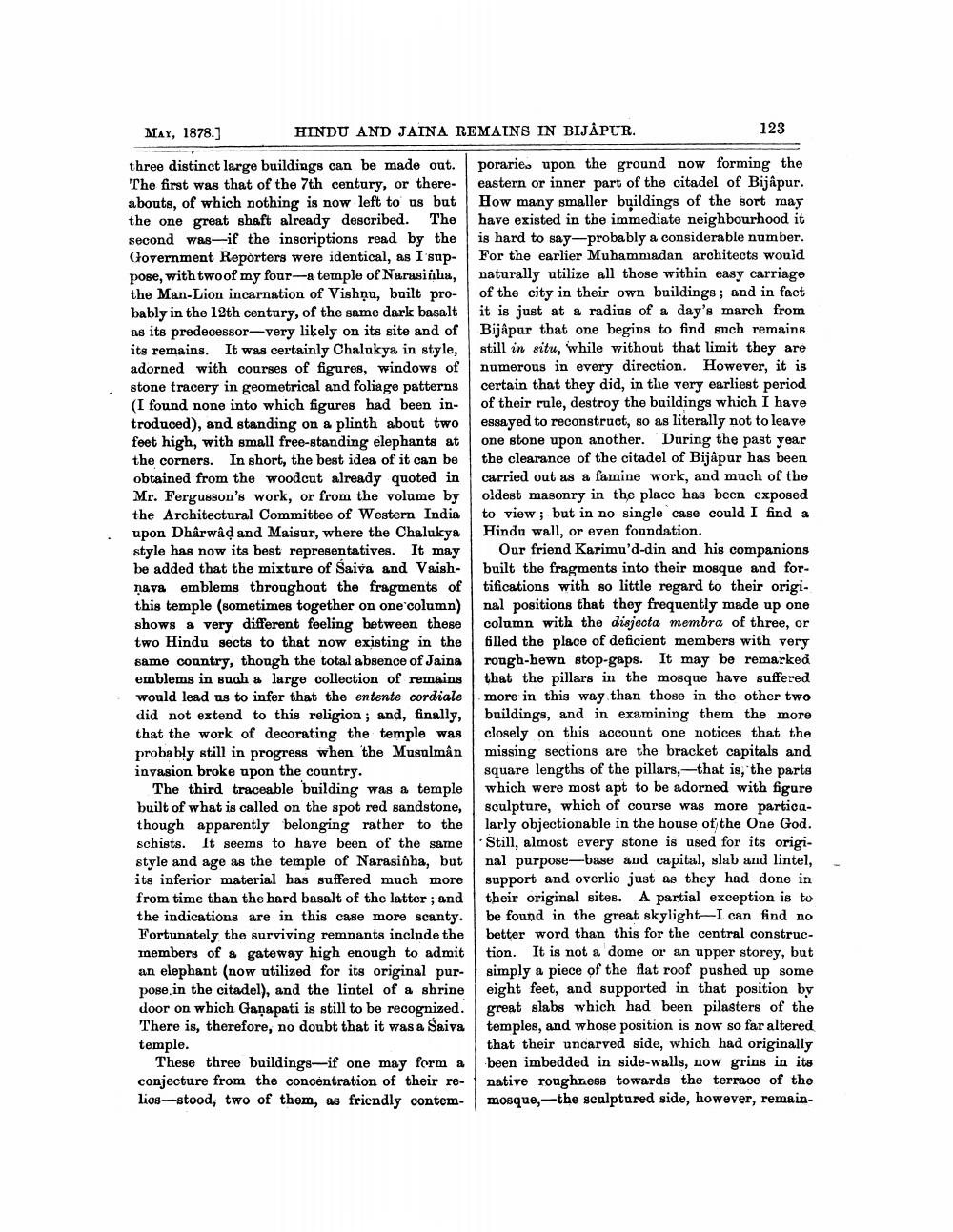________________
MAY, 1878.]
HINDU AND JAINA REMAINS IN BIJÅPUR.
123
three distinct large buildings can be made out. The first was that of the 7th century, or there abouts, of which nothing is now left to us but the one great shaft already described. The second was-if the inscriptions read by the Government Reporters were identical, as I suppose, with two of my four-a temple of Narasinha, the Man-Lion incarnation of Vishnu, built probably in the 12th century, of the same dark basalt as its predecessor-very likely on its site and of its remains. It was certainly Chalukya in style, adorned with courses of figures, windows of stone tracery in geometrical and foliage patterns (I found none into which figures had been introduced), and standing on a plinth about two feet high, with small free-standing elephants at the corners. In short, the best idea of it can be obtained from the woodcut already quoted in Mr. Fergusson's work, or from the volume by the Architectural Committee of Western India upon Dharwad and Maisur, where the Chalukya style has now its best representatives. It may be added that the mixture of Saiva and Vaishnava emblems throughout the fragments of this temple (sometimes together on one column) shows a very different feeling between these two Hindu sects to that now existing in the same country, though the total absence of Jaina emblems in such a large collection of remains would lead us to infer that the entente cordiale did not extend to this religion; and, finally, that the work of decorating the temple was probably still in progress when the Musalman invasion broke upon the country.
The third traceable building was a temple built of what is called on the spot red sandstone, though apparently belonging rather to the schists. It seems to have been of the same style and age as the temple of Narasinha, but its inferior material has suffered much more from time than the hard basalt of the latter; and the indications are in this case more scanty. Fortunately the surviving remnants include the members of a gateway high enough to admit an elephant (now utilized for its original pur- pose, in the citadel), and the lintel of a shrine door on which Ganapati is still to be recognized. There is, therefore, no doubt that it was a Saiva temple.
These three buildings-if one may form a conjecture from the concentration of their re- lics-stood, two of them, as friendly contem-
poraries upon the ground now forming the eastern or inner part of the citadel of Bijapur. How many smaller buildings of the sort may have existed in the immediate neighbourhood it is hard to say-probably a considerable number. For the earlier Muhammadan architects would naturally utilize all those within easy carriage of the city in their own buildings; and in fact it is just at a radius of a day's march from Bijapur that one begins to find such remains still in situ, while without that limit they are numerous in every direction. However, it is certain that they did, in the very earliest period of their rule, destroy the buildings which I have essayed to reconstruct, so as literally not to leave one stone upon another. During the past year the clearance of the citadel of Bijapur has been carried out as a famine work, and much of the oldest masonry in the place has been exposed to view ; but in no single case could I find a Hindu wall, or even foundation.
Our friend Karimu'd-din and his companions built the fragments into their mosque and fortifications with so little regard to their original positions that they frequently made up one column with the disjeota membra of three, or filled the place of deficient members with very rough-hewn stop-gaps. It may be remarked that the pillars in the mosque have suffered more in this way than those in the other two buildings, and in examining them the more closely on this account one notices that the missing sections are the bracket capitals and square lengths of the pillars,-that is, the parts which were most apt to be adorned with figure sculpture, which of course was more particularly objectionable in the house of the One God. Still, almost every stone is used for its original purpose-base and capital, slab and lintel, support and overlie just as they had done in their original sites. A partial exception is to be found in the great skylight-I can find no better word than this for the central construction. It is not a dome or an upper storey, but simply a piece of the flat roof pushed up some eight feet, and supported in that position by great slabs which had been pilasters of the temples, and whose position is now so far altered that their uncarved side, which had originally been imbedded in side-walls, now grins in its native roughness towards the terrace of the mosque,-the sculptured side, however, remain




